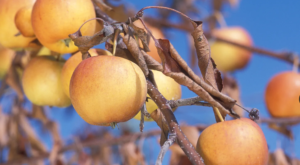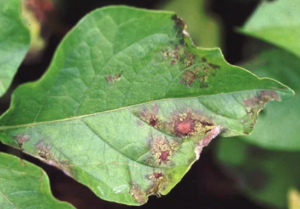Hello everyone, In this article we will know about blight disease and it’s important factor like introduction, identification, cause of blight, Precaution, and its treatment.
Introduction of Blight Disease
Blight fungal disease is a plant disease caused by various fungal pathogens. This term to describe a range of plants disease that causes rapid and severe damage, often leading to the death of plant tissue.

This disease may expand rapidly and can cause premature leaf drop or fruit rot. For instance, late blight affects potatoes and tomatoes, while early blight commonly targets tomatoes.
Blight fungi can spread through spores, which are often carried by wind, water, or contaminated soil and plant material. Common cause of diseases.
Include pathogens, like bacteria, fungi, or viruses, as well as environment condition such as drought, poor soil conditions.
Identification of Blight Disease

- Identification of blight involves specific symptoms and damage of plants. Dark, sunken spots of leave, stem and fruit.
- They can vary in colour and size depending on the pathogen. Sudden wilting of leave or entrie plants.
- Premature loss of leaves or yellowing , browning, darkening of plants tissue. Sunken, often darkened area stems or branches that can lead to dieback. Symptoms spreading quickly which is typical of blight, compared to slower-progressing disease.
- Identify the specific pathogen causing the blight through laboratory tests . And environment condition as blight can be influenced by factors like humidity, temperature and poor air circulation.
Read more:
- Malathion Insecticide : Best Information and uses in 2024
- A comprehensive guide about Systemic Herbicide for beginner 2024
Blight Disease can be caused by various factors
- The are caused by fungal pathogens. Example phytophthora infestans, which causes late blight of potatoes and tomatoes.
- Bacterial blight are caused by pathogen like Xanthomonas and pseudomonas.
- These can lead to symptoms such as leaf spots and cankers.
- Viral blight those caused by the tobbaco mosaic virus and necrosis of plants tissue.
- High humidity and rainfall create favourable conditions for many blight causing pathogen. Both high and low temperature can stress plant and make than more susceptible to blight.
- Dense planting or crowded conditions can trap moisture and increase the risk of blight.
Lack of essential nutrients can weaken plant making them more permeable blight. - Over watering and under watering can stress plants and make the more prone to blight.
- Soil that retains that too moisture can promote the development of blight. From harvesting, pruning or mechanical actions can serve as entry point for pathogens.
Precautions of Blight Disease
- Select resistant plant varieties specifically bred to resist common blight strains. The varieties are less susceptible to infection.
- Space plants to allow for good airflow around them. Crowded plants can trap moisture and create a humid environment conducive to blight development. Planting distance for each crop to prevent over crowding.
- Regular clean tools,pots and other equipment to prevent transferring pathogens from one plant to another.
- Keep the garden area free of fallen leaves and plant debris, which can harbor disease -causing organisms.
- Avoid planting the same crop in the same soil year after year. Rotate crop to break the lifecycle of Blight pathogens and reduce soil borne inoculum.
- Mulch help retain soil moisture and control weeds. Reduce humidity around plants using fan or other means.
- Ensure good soil drainage to avoid waterlogging.
Also Read:
- Rust Disease: Identification, Cause, Precaution And Treatment
-
Downy Mildew: Identification, Cause, Precaution And Treatment
Treatment of Blight Disease
- Apply fungicides specifically labeled for the type of blight affecting your plants . Follow application instructions carefully to avoid resistance issues.
- Use bactericides product for bacterial blight . They can manage and reduce the spread of bacterial pathogen.
- Infected plant part to reduce. Cut back affected plant parts to improve air circulation and reduce moisture around the plant. Clean and disinfect tools and equipment to prevent spreading pathogens.
- Crop rotation break the life cycle of soil borne pathogens . Avoid overhead watering and ensure proper drainage to reduce moisture that can promote pathogens.
- Use biological control agent such as beneficial fungi or bacteria that can inhibit blight -causing pathogens.
- Plant variety bred for resistant to specific blight pathogens. lmproved soil structure and nutrition level to support plant health. Implementing a combination of the treatment based on the specific type of blight and it’s impact will help manage and control the disease effectively.
Conclusion of Blight Disease
Blight fungal disease is the plant disease caused by various fungal pathogens. Premature loss of leave or yellowing, browning darkened of plants tissue.
Common cause of disease including pathogens like bacteria, fungi, virus and environment condition. Combining biological controls, resistant crop varieties and use of fungicides can effectively mitigate blight and practicing good field hygiene.
By integrating these approaches farm can mitigate the impact of pathogen and ensure more stable and productive agricultural systems.
1. What is blight disease?
Blight is the plant disease caused by rapid tissue death, often causing dark, sunken lesions or patches on leaves stems or fruits. it can be caused by various pathogens, including fungi, bacteria or viruses
2. What is the meaning of the word blight?
The word blight is a plant disease caused by fungi, bacteria, pr viruses that leads to the decay or death of the plant.
3. Is blight poisonous for human?
Blight disease themselves are not typically poisonous to human. The pathogens causing blight such as fungi, bacteria, viruses generally affect plants and do not produce toxins that are harmful to human.
4. How to treat blight?
To treat blight remove and discard infected plant parts improve, air circulation apply appropriate fungicides, practice crop rotation and maintain overall plant health.
5. Is blight a parasite?
No, blight is not parasite. It refers to a group of plant disease caused by various pathogen that can cause rapid and severe damage the plant.
6. Which plant gets blight disease?
Blight disease can affect a variety of plant including late blight and early blight in tomatoes. Late blight alse affect in potatoes. Apple can suffer from apple scab a form of blight.
7. What are the symptom of early blight?
The symptom of early blight in tomatoes and potatoes like
Leaf spots: Dark concentric circle with yellow halos on order leave.
Leaf yellowing: The area around the spota turn yellow, causing leave to wilt and drop prematurely.
8. Is blight disease a fungal?
Blight disease can be caused by different type of pathogens, including fungi, bacteria, or viruses . Early blight and late blight, for example, are fungal disease.

Pingback: Leaf spot: Identification, Cause, Precautions And Treatment -